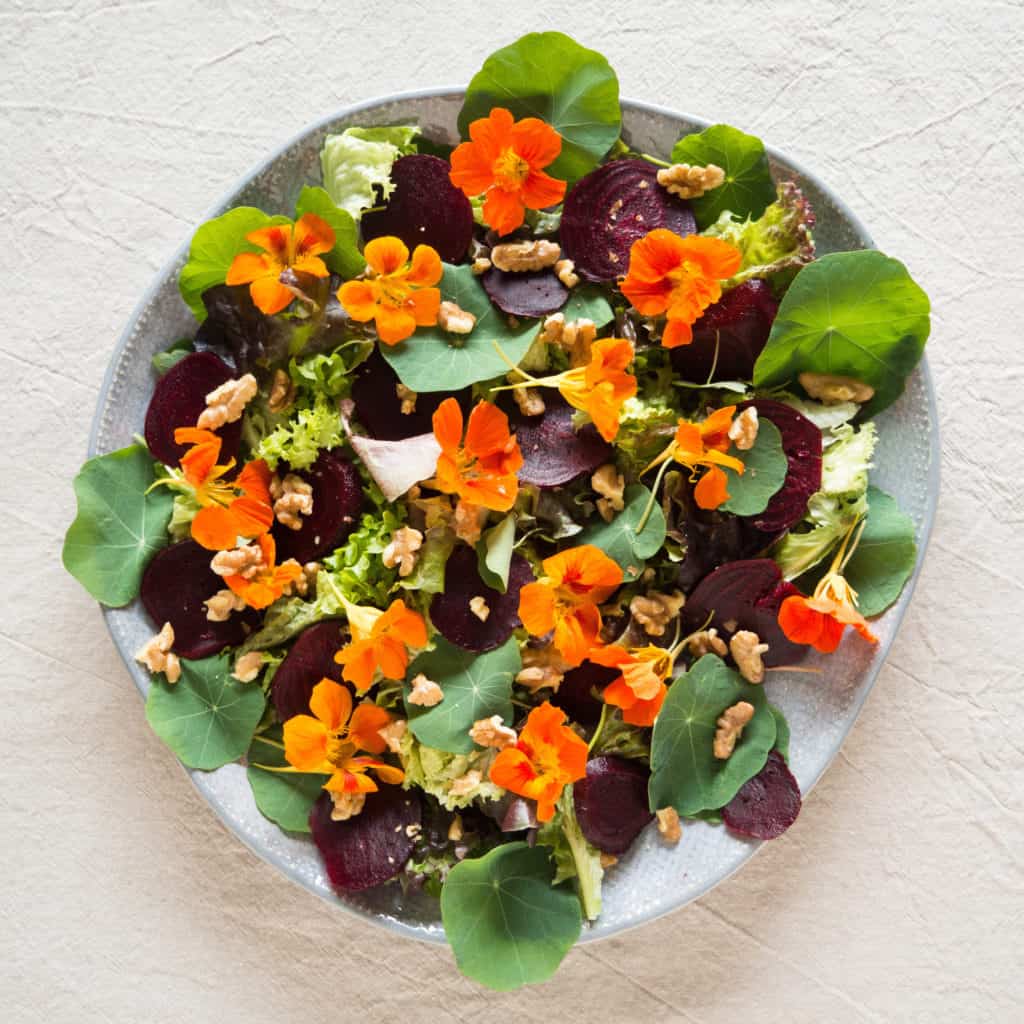
Nasturtium, Beetroot and Walnut Summer Salad not only looks incredible but also tastes incredible. Nasturtiums are the stars of this dish. Nasturtiums are probably the easiest edible flower to get hold of and they are the most striking. I remember first eating nasturtiums as a child. My Nana was growing some in her back garden and they were everywhere. I thought she was trying to trick me when she said we could eat them. They tasted incredible. Nasturtiums remind me of hot summers and beautiful warm carpets of colour.
The nasturtium (tropaeolum majus) is a climbing, sprawling hardy annual. Once the plant is established it just keeps on growing and giving and one plant will produce huge amounts of edible flowers and leaves for around 10 weeks (both flowers and the leaves are edible). Nasturtiums have a peppery sweet taste – a little bit like a floral watercress.
This Nasturtium, Beetroot and Walnut Summer Salad is very easy to pull together and looks amazing.
You can find the full Nasturtium, Beetroot and Walnut Summer Salad recipe here.
Nasturtium, Beetroot and Walnut Summer Salad is perfect for a light lunch, salad course with dinner or part of a very striking buffet. Great as a side to Ratatouille, Gluten Free, Vegan Quiche or Roasted Squash Soup.
When choosing the flowers and leaves pick whole flowers and leaves in good condition.
Preparation
Difficulty easy
Preparation time 15 minutes
Cooking time 0 minutes
You can find the full Nasturtium, Beetroot and Walnut Summer Salad recipe here.
Allergens
The Nasturtium, Beetroot and Walnut Summer Salad is gluten-free and vegan as well as…
Celery free
Coconut free
Garlic free
Lupin free
Mustard free*
Nightshade free
Onion free
Peanut free
Sesame free
Soya free
Tree nut free*
*To make Nasturtium, Beetroot and Walnut Summer Salad tree nut free leave out the walnuts and substitute the walnut oil for rapeseed oil in the vinaigrette.
*To make Nasturtium, Beetroot and Walnut Summer Salad mustard free dress the salad with oil and vinegar.
About
Nasturtium (tropaeolum) is a genus of approximately 80 species of annual and perennial herbaceous flowering plants. Nasturtium is the only genus in the family tropaeolaceae. The nasturtium is so called because they produce an oil similar to that of watercress (nasturtium officinale) but which is an unrelated plant.
Nasturtium are native to south and central America. The first tropaeolum species was brought to Spain by the Spanish botanist Nicolás Monardes around 1569. The nasturtium than spread through Europe.
Nasturium plants often have intensely bright flowers, and rounded, shield-shaped leaves. All parts of tropaeolum majus are edible. The flower is a very beautiful salad ingredient. It has a slightly peppery taste (similar to watercress). The flowers are usually eaten raw but can also be stir fried. One type of tropaeolum produces an edible underground tuber that is a major food source in parts of the Andes.
The flowers contain about 130 mg of vitamin C per 100 grams; about the same as parsley. Nasturtiums contain up to 45 milligrams of lutein per 100 grams which is the highest amount found in any edible plant. Unripe nasturtium seed pods can be picked and pickled to produce a condiment and garnish (sometimes used in place of capers).
Nasturtiums are often used as companion plants for biological pest control, repelling some pests, acting as a trap crop for others and attracting predatory insects.